Hardware Efficient Massive MIMO Systems with Optimal Antenna Selection
Abstract
:1. Introduction
- We introduce an energy-efficient downlink antenna selection technique for mobile and static users. The proposed technique considers two-phase selection:
- Optimal number of BS antennas () at which the energy efficiency graph becomes maximum and starts declining, is determined as, . For this, the following assumptions are used:
- –
- A maximum number users a BS can support is assumed, and all users are to be at the cell edge distances.
- –
- All BS antennas and RF components are employed to determine total downlink power consumption according to (34).
- –
- The channel is assumed to be random, and we consider fixed SNR (), which is the average of least SNR values from several random channel generations for cell edge as in (18). A minimum SNR value is considered to accommodate the worst-case in which the channel is in deep fading.
- Next, user mobility-based selection is made. In this case, our selection algorithm incorporates the exhaustive searching method to select a group of elements with the best channel gain as in (21) and (23). The double section also reduces the number of search combinations and computational complexity. Again, since double selection using algorithms one and two minimizes the number of RF components directly associated with the antenna elements in the case of digital beamforming, the power consumption is substantially reduced and makes the system energy efficient.In comparison to prior methods, our proposed algorithm lowers the computational complexity of the transceiver system.
- We design a heuristic and simple formulation of antenna selection to evaluate the performance for mMIMO at sub-6 GHz and mmWave bands with CI and FS path-loss models.
- We introduce an energy-efficient and optimal DAC resolution algorithm for massive MIMO systems.
- Finally, by integrating our novel algorithms, the effect of selection on the EE was evaluated with low resolution and typical DAC.
2. System Model and Description
3. Propagation Model and Analysis
3.1. Channel Model
3.2. Array Steering Vector
3.3. Signal Model
3.4. Mobile Location and Positioning
3.5. Close-In (CI) Path Loss Model
4. Antenna Selection and Power Model
4.1. Antenna Selection
4.2. Capacity and Power Consumption Model
| Algorithm 1: Initial access-based optimal number selection algorithm. |
 |
| Algorithm 2: Number and element selection after reduced distance. |
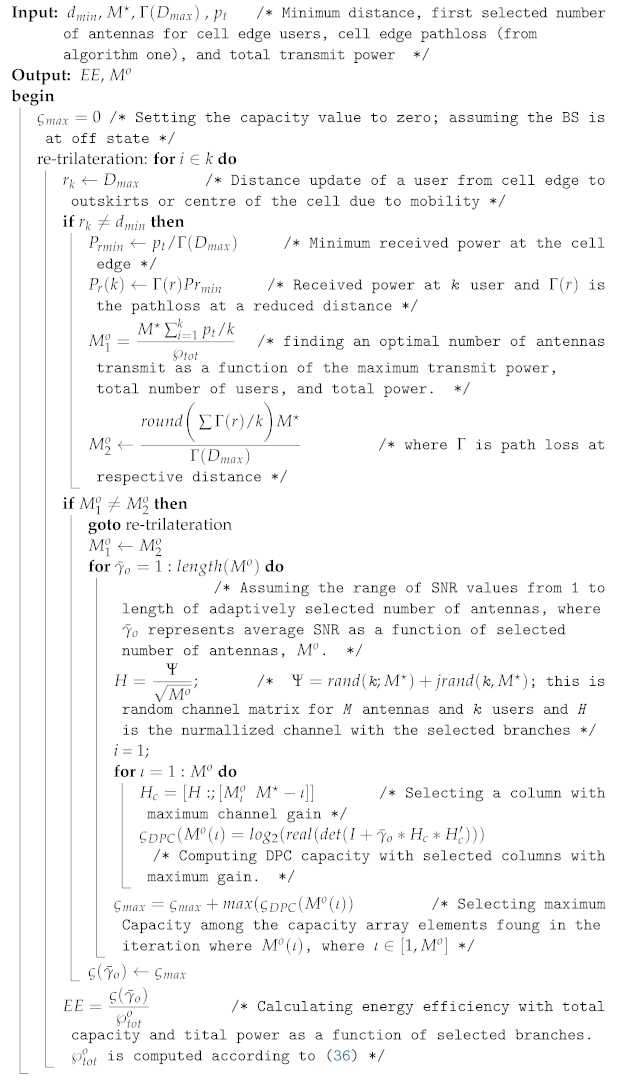 |
| Algorithm 3: Proposed algorithm for low resolution DAC. |
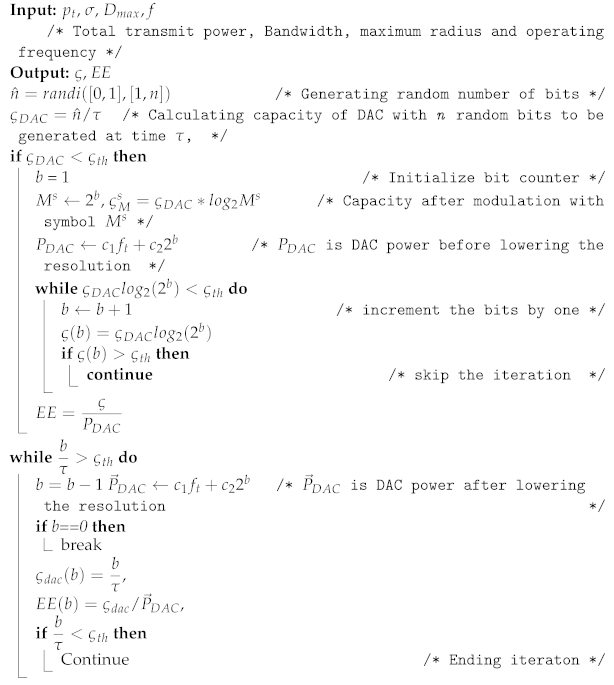 |
- In algorithm one, the selection is made with dynamic or nondeterministic channel conditions. The input for selection is a pilot signal, and the number is identified based on the optimal value of the EE curve.
- In algorithm two, the maximum number of antennas is transformed to , which was obtained as a new number in algorithm one.
- After identifying the minimum received signal at the cell edge and an optimal number of antennas () using the initial access condition in algorithm one, the number of antennas is adaptively reduced. Instead of reducing the transmit power when users move from the cell edge area to the cell centre positions, in this case, the number of antennas is reduced, maintaining the minimum required SNR for connection quality. Then, after finding the average SNR, the number is changed from to .
- After identifying , the branches with best channel gains are selected from iteratively, and the DPC capacity is computed.
- Assuming fixed SNR at the cell edge, the minimum capacity is obtained and considered as a threshold capacity. Here, the free space propagation model is considered, and small-scale fading is ignored.
- Through randomly generated bits, the capacity of DAC is calculated and compared with the threshold.
- If the capacity of DAC, which was obtained with random bits, is greater than the threshold capacity, then DAC down resolution is done by iteratively decreasing the number of bits before analogue conversion is done. This reduction in bits ultimately reduces the operating power consumption of DAC according to (14). This DAC power directly affects the total system power consumption according to (37).
- Finally, the EE is computed as a function of the capacity and total power with low resolution. Throughout the evaluation process in this paper, the following parameters in Table 2 are used.
5. Results and Analysis
6. Conclusions
Author Contributions
Funding
Institutional Review Board Statement
Informed Consent Statement
Data Availability Statement
Conflicts of Interest
Abbreviations
| AoA | Angle of Arrival |
| AoD | Angle of Departure |
| BS | Base Station |
| CI | Close In |
| DAC | Digital to Analogue Conversion |
| EE | Energy Efficiency |
| mMIMO | massive Multiple Input Multiple Output |
| RF | Radio Frequency |
| SE | Spectral Efficiency |
| SNR | Signal-to-Noise Ratio |
| ZoD | Azimuth Angle of Departure |
References
- Larsson, E.G.; Tufvesson, F.; Edfors, O.; Marzetta, T.L. Massive MIMO for next-generation wireless systems. IEEE Commun. Mag. 2014, 52, 186–195. [Google Scholar] [CrossRef] [Green Version]
- Heath, R.W.; Sandhu, S.; Paulraj, A. Antenna selection for spatial multiplexing systems with linear receivers. IEEE Commun. Lett. 2001, 5, 142–144. [Google Scholar] [CrossRef]
- Rusek, F.; Persson, D.; Lau, B.K.; Larsson, E.G.; Marzetta, T.L.; Edfors, O.; Tufvesson, F. Scaling up MIMO: Opportunities and Challenges with Very Large Arrays. IEEE Signal Process. Mag. 2013, 30, 40–60. [Google Scholar] [CrossRef] [Green Version]
- Correia, L.; Zeller, D.; Blume, O.; Ferling, D.; Jading, Y.; Godor, I.; Auer, G.; van der Perre, L. Challenges and enabling technologies for energy-aware mobile radio Networks. IEEE Commun. Mag. 2010, 48, 6672. [Google Scholar] [CrossRef]
- Ribeiro, L.; Schwarz, S.; Rupp, M.; de Almeida, A.L.F. Energy efficiency of mmWave massive MIMO precoding with low-resolution DACs. IEEE J. Sel. Top. Signal Process. 2018, 12, 298–312. [Google Scholar] [CrossRef] [Green Version]
- Vlachos, E.; Kaushik, A.; Thompson, J. Energy-efficient transmitter with low resolution DACs for massive MIMO with partially connected hybrid architecture. In Proceedings of the IEEE 2018 87th Vehicular Technology Conference (VTC Spring), Porto, Portugal, 3–6 June 2018; pp. 1–5. [Google Scholar]
- Ding, Q.; Deng, Y.; Gao, X. Spectral and energy efficiency of hybrid precoding for mmWave massive MIMO with low-resolution ADCs/DACs. IEEE Access 2019, 7, 186529–186537. [Google Scholar] [CrossRef]
- Moghadam, N.N.; Fodor, G.; Bengtsson, M.; Love, D.J. On the energy efficiency of MIMO hybrid beamforming for millimeter-wave systems with nonlinear power amplifiers. IEEE Trans. Wirel. Commun. 2018, 17, 7208–7221. [Google Scholar] [CrossRef] [Green Version]
- Jacobsson, S.; Duris, G.; Coldrey, M.; Goldstein, T.; Studer, C. Quantized precoding for massive MU-MIMO. IEEE Trans. Commun. 2017, 65, 4670–4684. [Google Scholar] [CrossRef]
- Rabie, E.; Shokair, S. A Proposed Efficient Hybrid Precoding Algorithm for millimetre-wave Massive MIMO 5G Networks. Wirel. Pers. Commun. 2020, 112, 1–16. [Google Scholar]
- Albreem, M.A.; Al Habbash, A.H.; Abu-Hudrouss, A.M.; Ikki, S.S. Overview of precoding techniques for massive MIMO. IEEE Access 2021, 9, 60764–60801. [Google Scholar] [CrossRef]
- Yang, P.; Zhu, J.; Chen, Z. Antenna selection for MIMO system based on pattern recognition. Digit. Commun. Netw. 2019, 5, 34–39. [Google Scholar] [CrossRef]
- Gharavi-Alkhansari, M.; Gershman, A. Fast Antenna Subset Selection in MIMO Systems. IEEE Trans. Signal Process. 2004, 52, 339–347. [Google Scholar] [CrossRef]
- Dua, A.; Medepalli, K.; Paulraj, A.J. Receive Antenna Selection in MIMO Systems Using Convex Optimization. IEEE Trans. Wirel. Commun. 2006, 5, 2353–2357. [Google Scholar] [CrossRef]
- Wang, B.; Hui, T.; Leong, M.S. Global and Fast Receiver Antenna Selection for IMO Systems. IEEE Trans. Common. 2006, 58, 2505–2510. [Google Scholar] [CrossRef]
- Xu, Z.; Sfar, S.; Blum, R.S. Analysis of MIMO systems with receive antenna selection in spatially correlated Rayleigh fading channels. IEEE Trans. Veh. Technol. 2009, 58, 251262. [Google Scholar]
- Masouros, C.; Alsusa, E. Dynamic linear precoding for the exploitation of known interference in MIMO broadcast systems. IEEE Trans. Wirel. Commun. 2009, 8, 1396–1404. [Google Scholar] [CrossRef]
- Gesbert, M. Soft linear precoding for the downlink of DS/CDMA communication systems. IEEE Trans. Veh. Technol. 2010, 59, 203215. [Google Scholar]
- Xiang, E.; Liu, J.; Tufvesson, F. Antenna selection in measured massive MIMO channels using convex optimization. In Proceedings of the 2013 IEEE Globecom Workshops (GC Wkshps), Atlanta, GA, USA, 9–13 December 2013. [Google Scholar]
- Zhang, X.; Zhao, F. Hybrid Precoding Algorithm for Millimeter-Wave Massive MIMO Systems with Sub connection Structures. Wirel. Commun. Mob. Comput. 2021, 2021, 5532939. [Google Scholar] [CrossRef]
- Husbands, R.; Ahmed, Q.; Wang, J. Transmit Antenna Selection for Massive MIMO: A Knapsack Problem Formulation. In Proceedings of the 2017 IEEE International Conference on Communications (ICC), Paris, France, 21–25 May 2017. [Google Scholar]
- Bogale, T.E.; Le, L.B.; Haghighat, A.; Vandendorpe, L. On the Number of RF Chains and Phase Shifters, and Scheduling Design with Hybrid Analog-Digital Beamforming. IEEE Trans. Wirel. Commun. 2016, 15, 3311–3326. [Google Scholar] [CrossRef] [Green Version]
- Kanhere, O.; Rappaport, T.S. Outdoor sub-THz Position Location and Tracking using Field Measurements at 142 GHz. In Proceedings of the 2021 IEEE International Conference on Communications (ICC), Montreal, QC, Canada, 14–23 June 2021; pp. 1–6. [Google Scholar]
- Rappaport, T. Wireless Communications: Principles and Practice, 2nd ed.; Prentice-Hall: Upper Saddle River, NJ, USA, 2002. [Google Scholar]
- Molisch, A.F.; Win, M.Z.; Winters, J.H. Capacity of MIMO Systems with Antenna Selection. IEEE Trans. Wirel. Commun. 2005, 4, 1759–1772. [Google Scholar] [CrossRef] [Green Version]
- Rappaport, T. Wideband millimeter-wave propagation measurements and chan-new models for future wireless communication system design (Invited Paper). IEEE Trans. Commun. 2015, 63, 30293056. [Google Scholar] [CrossRef]
- Challita, F.; Lienard, M.; Gaillot, P.; Pardo, M. Evaluation of an Antenna Selection Strategy for Reduced Massive MIMO Complexity. Radio Sci. 2021, 56, e2020RS007242. [Google Scholar] [CrossRef]
- Yu, W.; Wang, T.; Wang, S. Multi-Label Learning-Based Antenna Selection in Massive MIMO Systems. IEEE Trans. Veh. Technol. 2021, 70, 7255–7260. [Google Scholar] [CrossRef]
- Kim, S. Efficient Transmit Antenna Subset Selection for Multiuser Space–Time Line Code Systems. Sensors 2021, 21, 2690. [Google Scholar] [CrossRef]
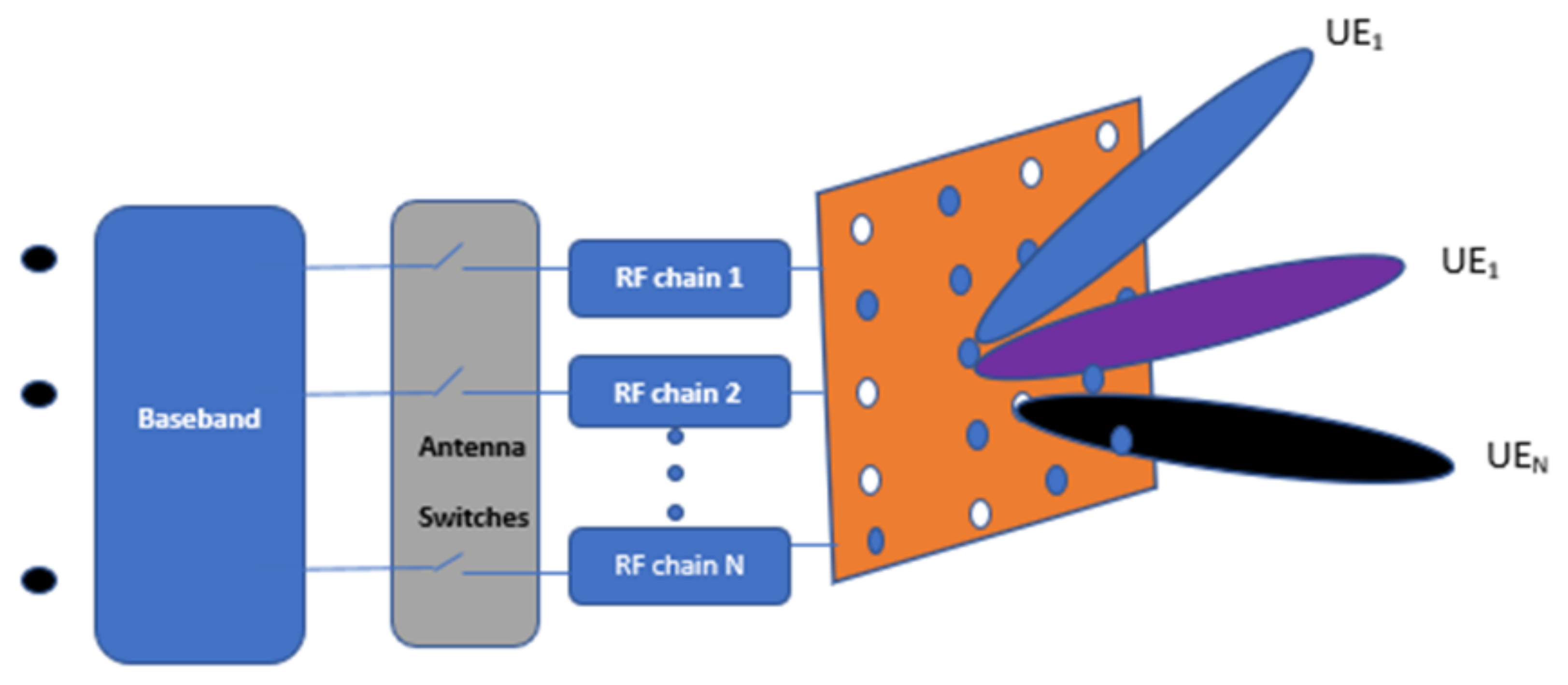
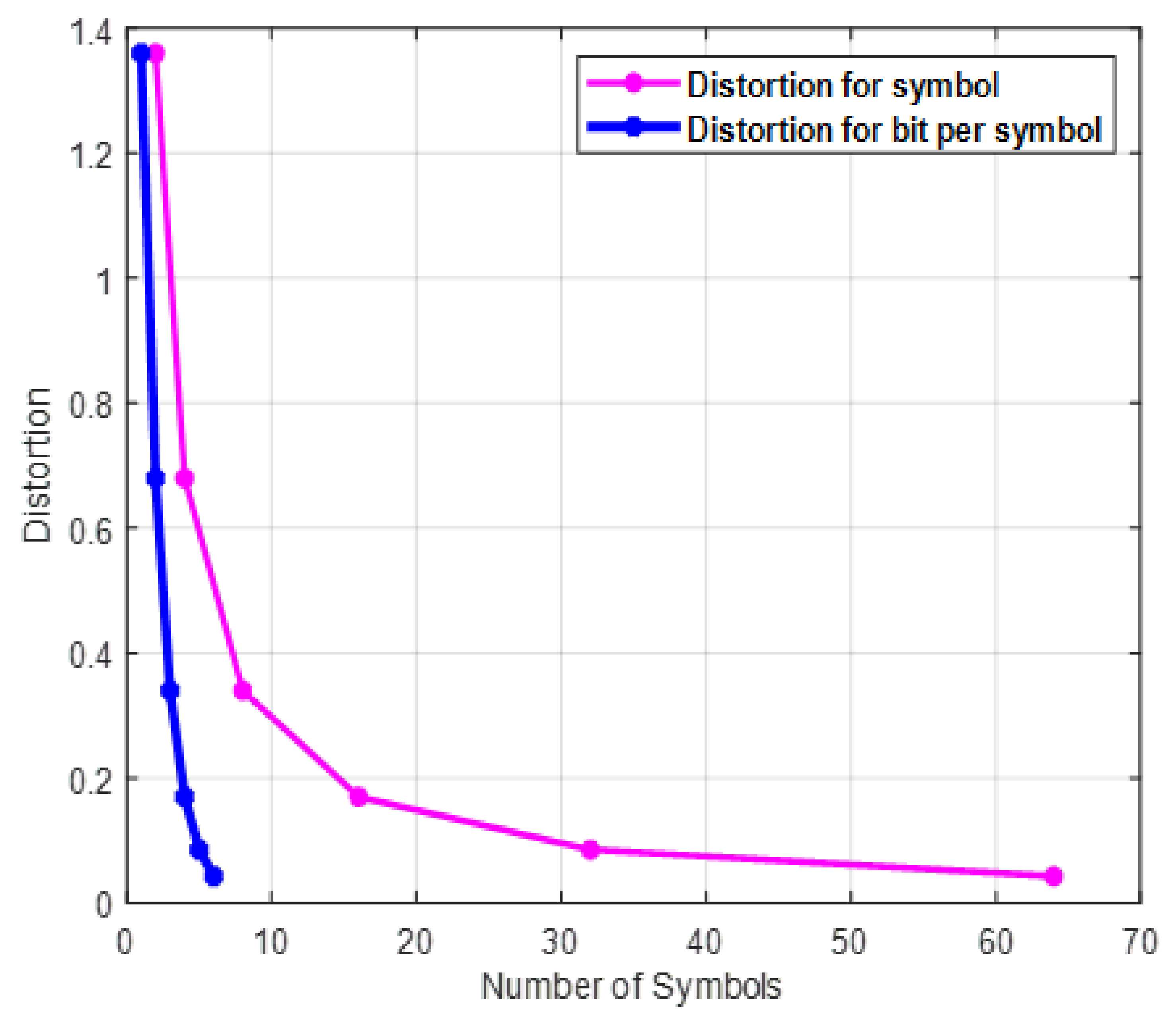
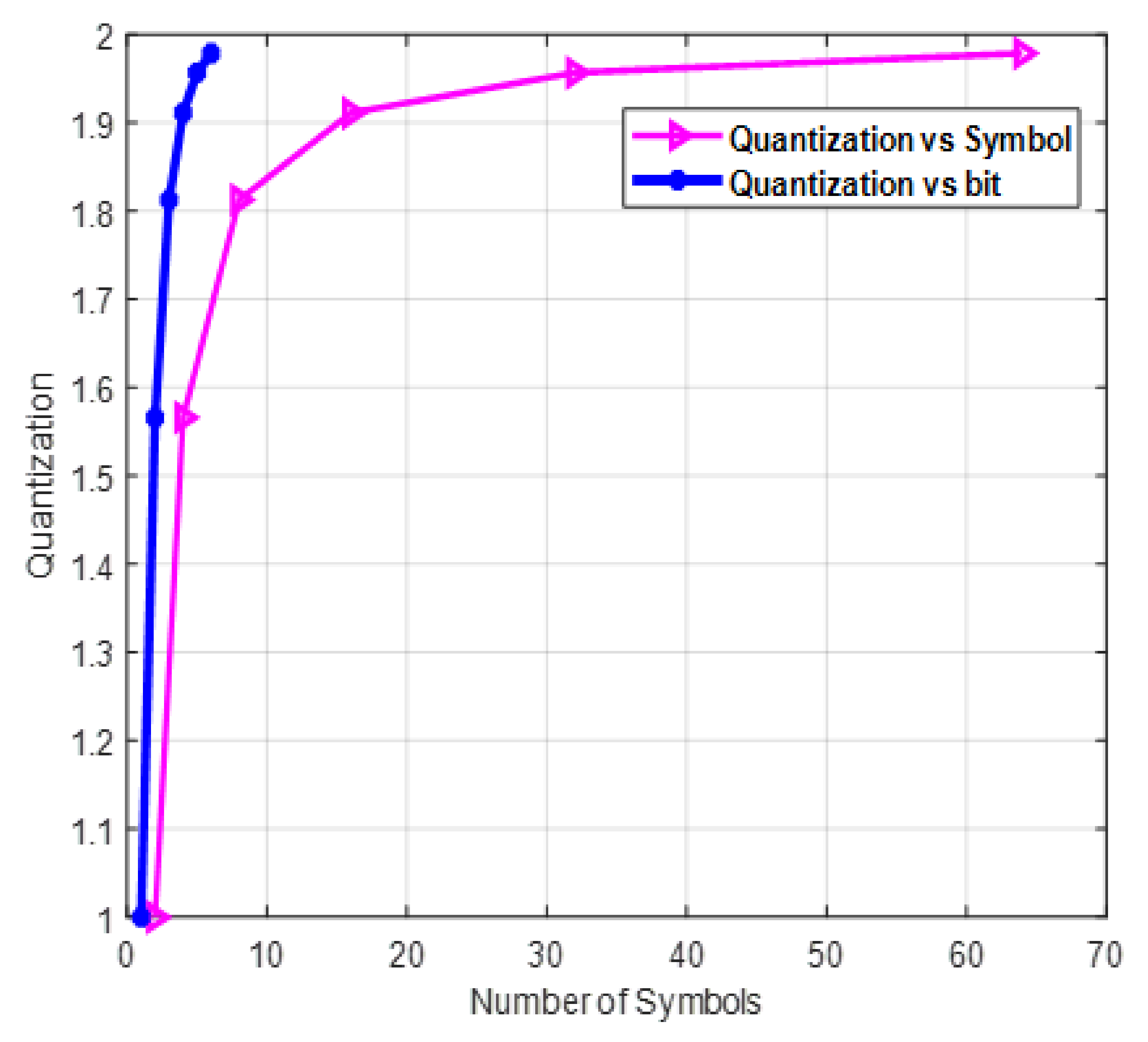
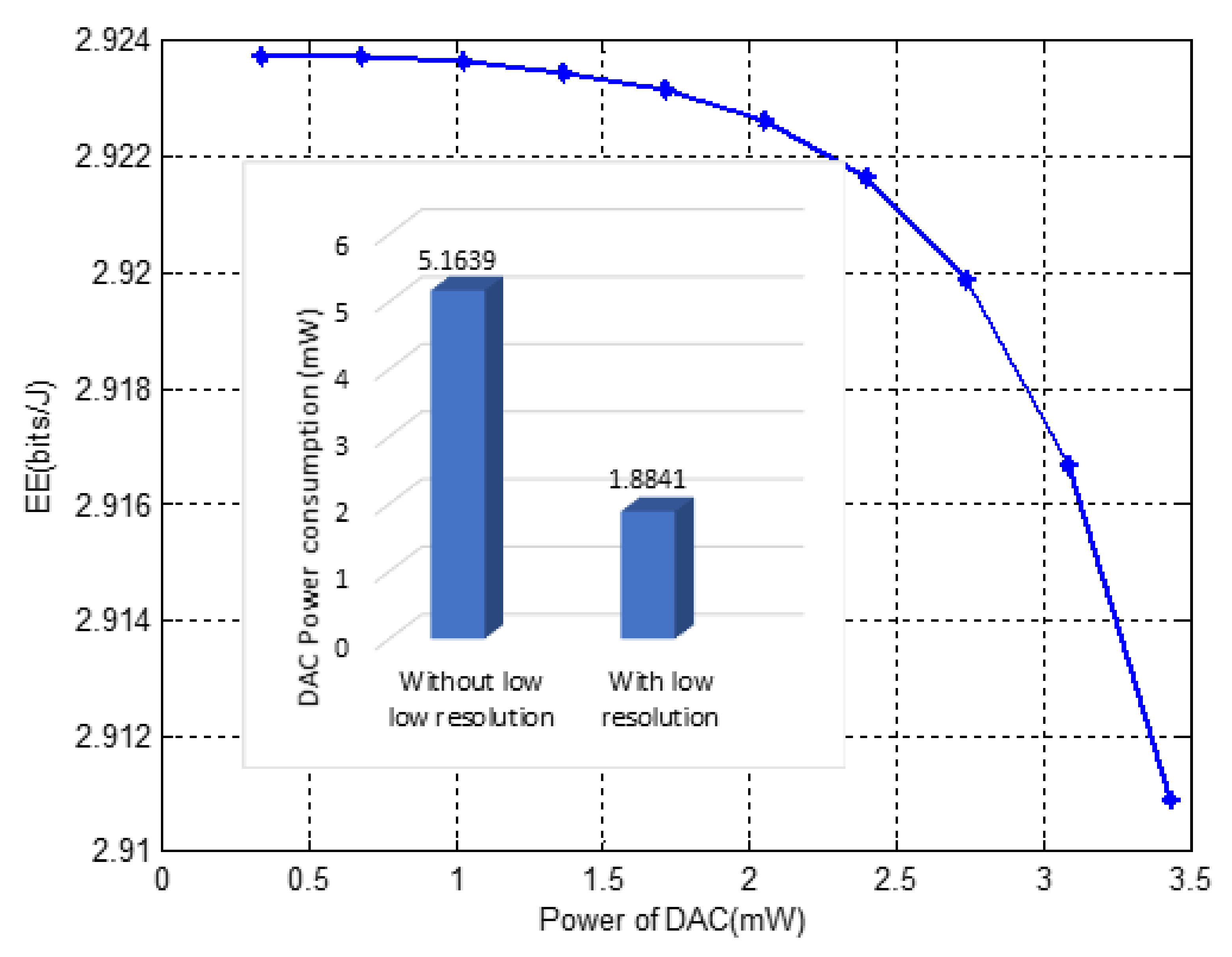





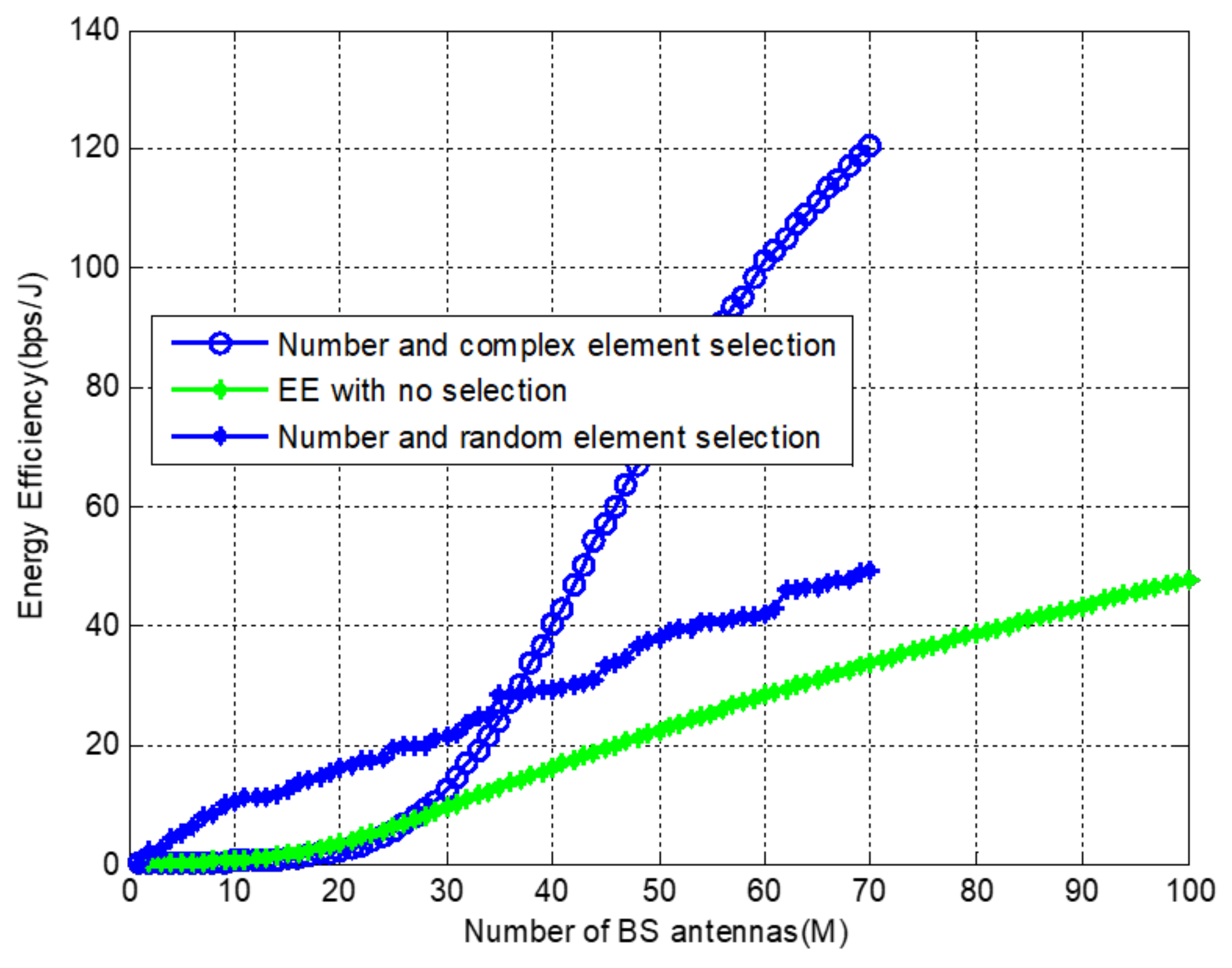
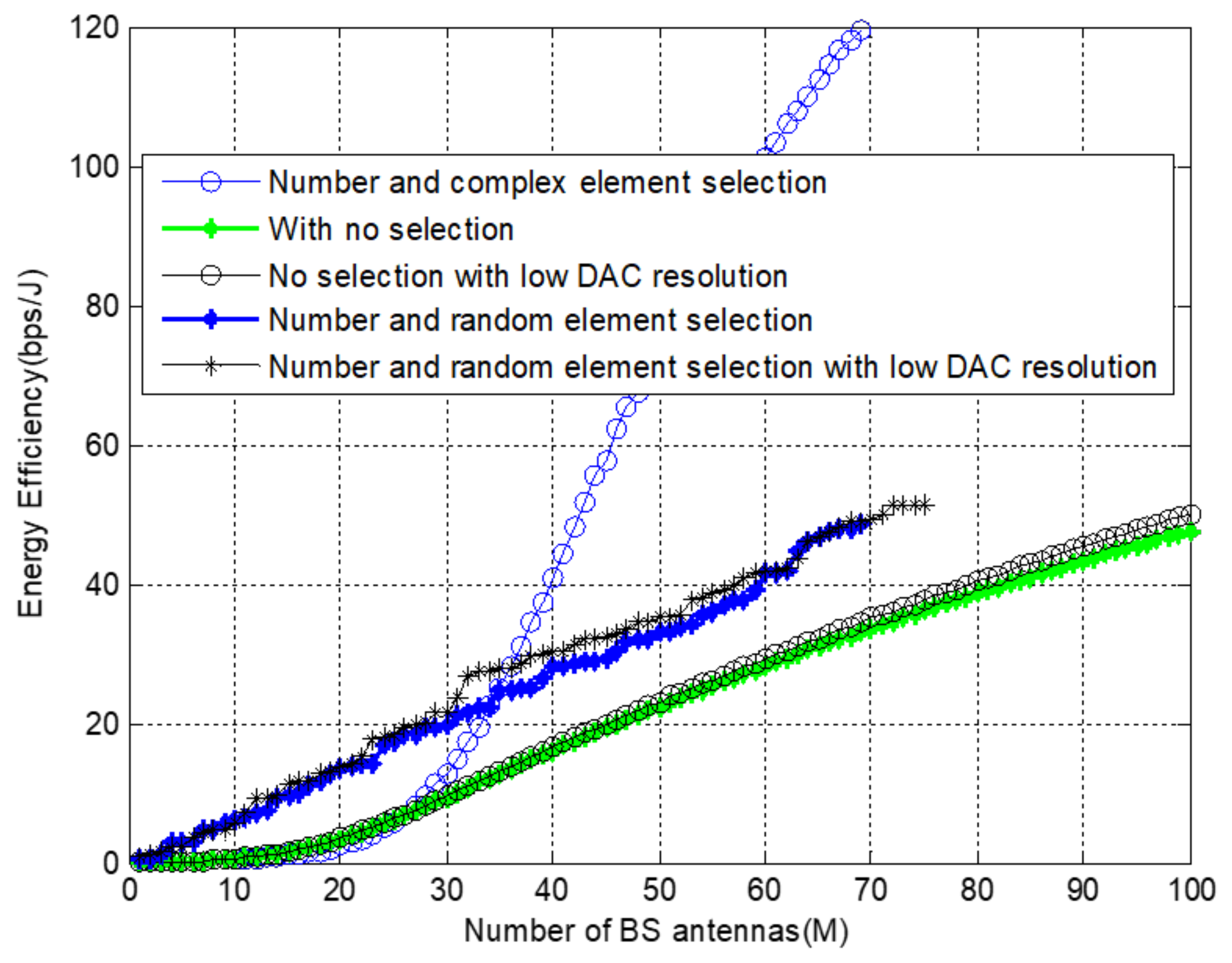
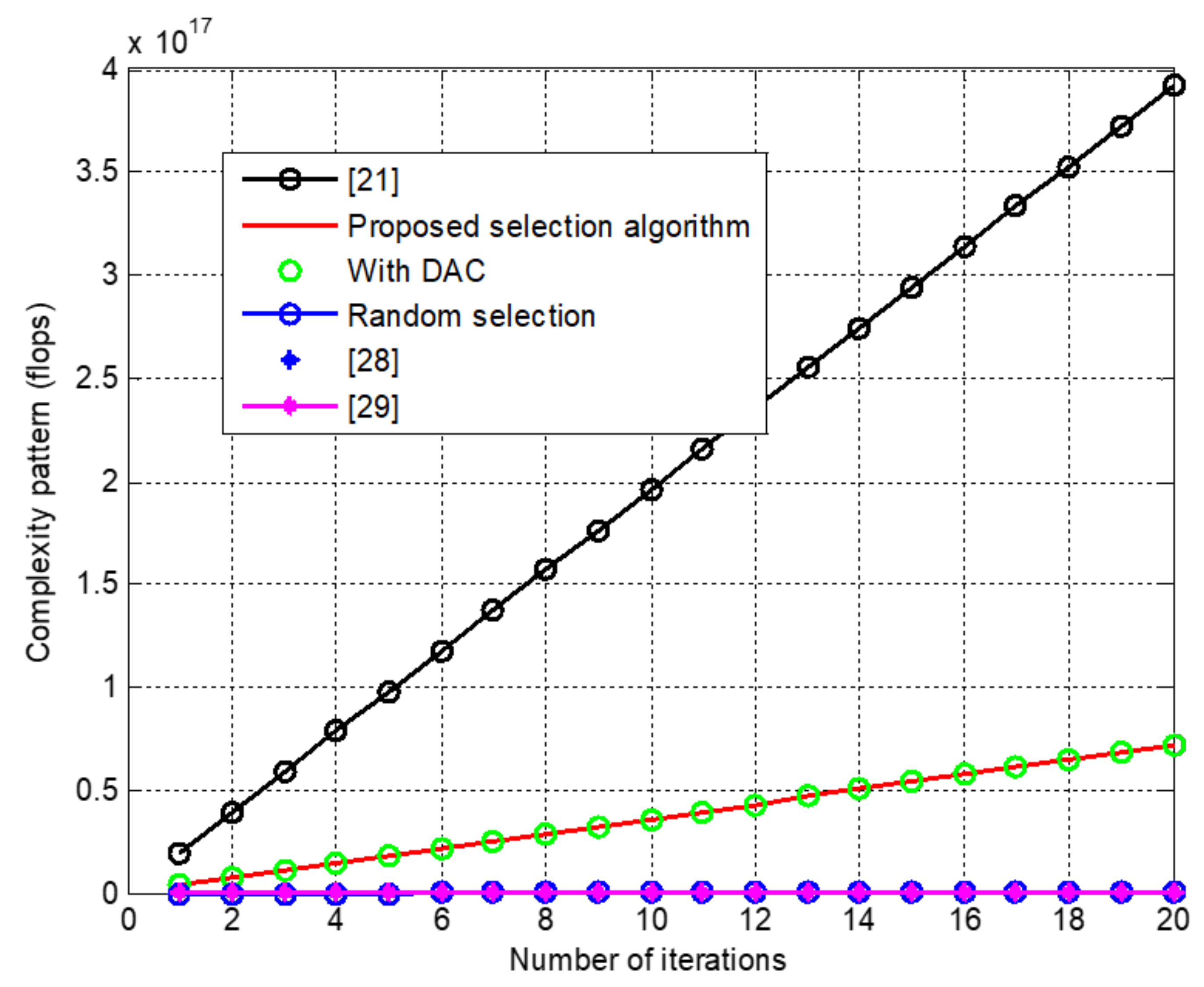
| Algorithm 2 | Algorithm 1 + 2 | Algorithm 1 + 2 + 3 |
|---|---|---|
| Parameter | Description | Value |
|---|---|---|
| Static power of DAC | ||
| Dynamic power of DAC | ||
| B | Channel bandwidth | 40 MHz |
| Cell edge distance | 200 m | |
| Minimum distance | 3 m | |
| f | Operating frequency | 38 GHz |
| Total average SNR at the cell edge | ||
| c | Speed of light | m/s |
| Path loss at cell edge distance | ||
| Random bit generation time interval | 5 ms | |
| Amplifier power | 0.05 mW | |
| Mixer power | 0.04 mW | |
| Local oscillator power | 0.01 mW | |
| Large-scale signal fluctuations due to the CI pathloss model | 4.4 dB | |
| Low pass filter power | 0.012 mW | |
| Hybrid with buffer power | 0.033 mW |
Publisher’s Note: MDPI stays neutral with regard to jurisdictional claims in published maps and institutional affiliations. |
© 2022 by the authors. Licensee MDPI, Basel, Switzerland. This article is an open access article distributed under the terms and conditions of the Creative Commons Attribution (CC BY) license (https://creativecommons.org/licenses/by/4.0/).
Share and Cite
Aredo, S.C.; Negash, Y.; Marye, Y.W.; Kassa, H.B.; Kornegay, K.T.; Diba, F.D. Hardware Efficient Massive MIMO Systems with Optimal Antenna Selection. Sensors 2022, 22, 1743. https://doi.org/10.3390/s22051743
Aredo SC, Negash Y, Marye YW, Kassa HB, Kornegay KT, Diba FD. Hardware Efficient Massive MIMO Systems with Optimal Antenna Selection. Sensors. 2022; 22(5):1743. https://doi.org/10.3390/s22051743
Chicago/Turabian StyleAredo, Shenko Chura, Yalemzewd Negash, Yihenew Wondie Marye, Hailu Belay Kassa, Kevin T. Kornegay, and Feyisa Debo Diba. 2022. "Hardware Efficient Massive MIMO Systems with Optimal Antenna Selection" Sensors 22, no. 5: 1743. https://doi.org/10.3390/s22051743
APA StyleAredo, S. C., Negash, Y., Marye, Y. W., Kassa, H. B., Kornegay, K. T., & Diba, F. D. (2022). Hardware Efficient Massive MIMO Systems with Optimal Antenna Selection. Sensors, 22(5), 1743. https://doi.org/10.3390/s22051743






